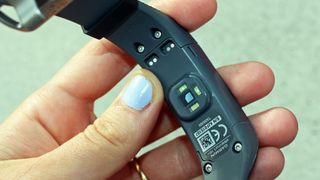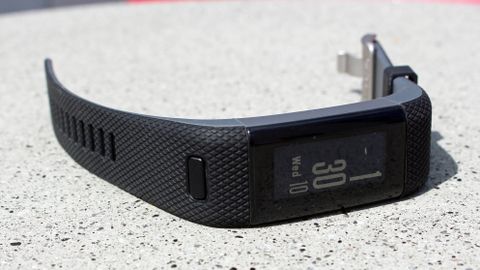Why you can trust TechRadar
The Vivosmart HR+ doesn't support any external HR chest straps, which is surprising because many other Garmin products do. The thinking here is likely that the wrist-based sensor is enough, which goes to show this is definitely a high-end tracker - and ideal for fitness - but those with serious training in mind might need something smart, like one of the brand's Forerunner range.
One thing the Vivosmart does do well is send your heart rate to other devices in the Garmin ecosystem, like the VIRB cameras. Although we're not sure how many diehard Garmin fans are out there with that many products from the brand.
The Garmin app works with both iOS and Android devices, although there's also a web portal. This works with devices connected to a PC or Mac, so pretty much anyone can use it.

Battery life
- 5 to 6 days on a single charge
- Charging cradle can be fiddly
The battery on the Vivosmart HR+ tends to last between five and six days. That's using all of the features, getting far too many notifications and taking it out for a handful of indoor runs as well as a few outdoor runs using GPS.
In comparison to some of the more basic trackers on the market this seems short, but taking into account just how many sensors are doing their thing at once, it's actually pretty impressive.

According to Garmin, the device would only last about 8 hours if you were to have the GPS on constantly, although we didn't have time to go on an 8 hour+ run or hike to put that to the test.
To charge up the Vivosmart HR+ you connect it to a cradle that plugs into your computer via USB. It kind of 'clicks' into place and felt a bit fiddly at first.
A few weeks on, it doesn't bother us too much, but it does mean there's an extra thing to pack if you're travelling. Hardly a deal-breaker, but just a bit annoying.
Verdict
The Garmin Vivosmart HR+ is one of our favorite wearable devices for fitness because it serves up all of the data you need and it does it in a way that feels intuitive and, refreshingly, easy.
Who's this for?
The HR+ is not likely to pique the interest of those after a super stylish device, or one that looks like a traditional timepiece. But having said that, it's not as if it looks particularly bad. It's for those who value substance, good data and a subtle device over aesthetics.
It's ideal for those who need something more than a Misfit Shine or Fitbit Flex, but don't workout enough to justify a heavy duty running device that looks like a computer strapped to their wrist - not to mention the price tag to match, like Garmin's much more serious Forerunner range.
On the other hand, you don't have to be smashing out the 5km runs to appreciate it. If you just need an activity tracker for now, but know you want to take fitness a little more seriously, investing in this device would give you a great excuse, and means you won't be clamoring for more functionality and better sensors a few months in when hitting 10,000 steps just doesn't do it for you anymore.

Should you buy it?
The Vivosmart HR+ falls short for specific tracking of some activities - notably swimming and cycling – which is disappointing. But if you're that into swimming there are plenty of other devices at your disposal, like Misfit's Speedo Shine.
For runners though, particularly those who value substance over style, the Garmin Vivosmart HR+ could be the wearable your wrist has been missing.
First reviewed: August 2016
Current page: Compatibility, battery life and verdict
Prev Page Specs, performance and fitnessBecca is a contributor to TechRadar, a freelance journalist and author. She’s been writing about consumer tech and popular science for more than ten years, covering all kinds of topics, including why robots have eyes and whether we’ll experience the overview effect one day. She’s particularly interested in VR/AR, wearables, digital health, space tech and chatting to experts and academics about the future. She’s contributed to TechRadar, T3, Wired, New Scientist, The Guardian, Inverse and many more. Her first book, Screen Time, came out in January 2021 with Bonnier Books. She loves science-fiction, brutalist architecture, and spending too much time floating through space in virtual reality.


